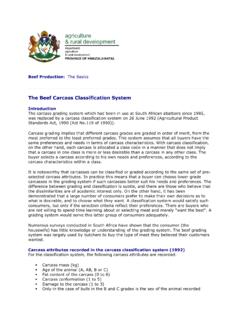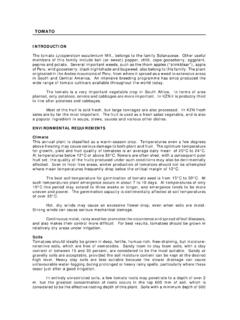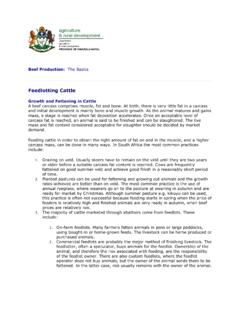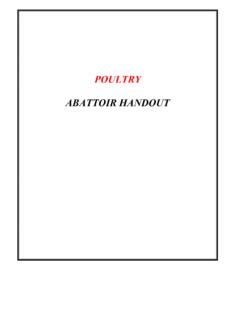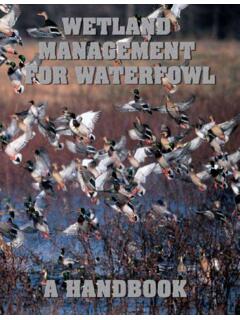Transcription of Sunflower Production - Concise GuideA
1 Sunflower Production - A Concise Guide Introduction Sunflower is a crop which, compared to other crops, performs well under drought conditions; this is probably the main reason for the crop's popularity in the marginal areas of South Africa. Unfortunately, the crop is particularly sensitive to high soil temperatures during emergence and it is especially in the sandy soil of the Western Free State and the North West Province where this problem often leads to poor or erratic plant density. In large parts of the Sunflower producing areas, the soil has acidified dramatically during the last decade.
2 Consequently, molybdenum shortages often occur and are possibly one of the greatest yield-limiting factors. The crop is very susceptible to bird damage and for this reason, it cannot be cultivated at all in some areas. On the positive side, however, the drought tolerance and low input cost of the crop are major advantages. The short growth season of the crop, which has the consequence that it can be planted over a period of at least three months, renders it extremely suitable for producers who make use of adaptable crop rotation and/or fallow systems. In any case, Sunflower is a crop which only belongs in a crop rotation system.
3 Soil requirements Sunflower adapts relatively well to a wide variety of soil types. Traditionally, Sunflower cultivation has been limited to soils where the clay percentage varies between 15 and 55 %, In other words sandy loam to clay soil types. At present, the major planting areas are in soils with a clay percentage of less than 20 %. In South Africa, a shortage of water is the main factor limiting crop Production . It is important that the available water is used to the best advantage. Especially in the more arid western areas, it is essential that as much water as possible be stored in the soil profile before planting , to limit the chance of failure.
4 The Sunflower plant has a deep and finely branched tap-root system which can utilize water from deep soil layers, even deeper than 2 m. Consequently, the crop often performs well even during a dry season, especially in deeper soils or in soils with a water-table. Because of its unique water-use pattern and root system the shallow soils which are found mainly in the eastern areas, such as shallow Westleigh, Estcourt, Kroonstad and other duplex soils, are suitable for the cultivation of Sunflower as well. Sunflower is capable of utilizing water from the clay horizons of these soils.
5 The potential for high yields on these soils is, however, limited. The following characteristics of soils will limit successful Sunflower Production and should be avoided: Sunflower is very sensitive to wind damage in the seedling stage and for this reason, cultivation on light-textured soils susceptible to wind erosion, should be avoided unless wind erosion is being combated successfully. Sunflower is very sensitive to water-logging. Sunflower is very sensitive to high aluminium levels and should not be planted in soils with a pH lower than 4,6 (KCI). Yield potential From a management point of view, it is essential to make a reliable assessment of the yield potential, with effective planning in mind.
6 Plant density, cultivar and especially the fertilisation programme cannot be planned unless yield potential has been accurately determined. Table 1 provides a guideline for the determination of yield potential. TABLE 1. Yield potential in relation to soil depth and rainfall for loam soils (kg/ha) Soil Depth Rainfall (mm) 500 550 650+ 40-60 1 000 1 200 1 500 60-80 1 300 1 500 1 900 80+ 1 300 1 600 2 200 Guidelines for the choice of Sunflower cultivars Choice of cultivar is an important facet in the Production process and its effect is often underrated. Choosing the right cultivars is one way of ensuring higher profits at no extra cost.
7 Sunflower is not very subject to diseases and from a Production point of view, disease resistance and quality do not play a major role yet. For this reason, yield and yield reliability are by far the most important criteria when cultivars are evaluated. The yield reliability of a cultivar at a certain yield potential is the minimum yield which will be achieved by that cultivar in nine out of ten cases. Yield reliability therefore takes the yield disposition, average yield and the riskiness of a cultivar into account, It is a very reliable criterion which can be used for cultivar recommendations.
8 Further detail on specific cultivars is covered by a separate leaflet, which is updated annually and is available from the ARC-Grain Crops Institute on request. Soil cultivation Production stability can be enhanced by the application of cultivation practices which limit moisture stress as far as possible. The point of departure in soil preparation should be to utilise rainfall and soil moisture to a maximum, Soil preparation should be focused on decreasing runoff losses, especially in the case of soils with a low infiltration rate. These losses can be limited to a great extent by applying the correct soil cultivation practices.
9 Primary cultivations, such as ploughing with a mouldboard plough or chisel plough, are suitable. The aim of the cultivation is to break up limiting layers, destroy weeds, provide a suitable seedbed and to break the soil surface at the same time to ensure maximum rainfall infiltration as well as to prevent wind and water erosion. Sunflower is usually cultivated in rotation with maize or sorghum and benefits from the dense mulches of these crops. Mulches protect the soil against the impact of raindrops, which seals the surface and reduces the infiltration rate but may enhance some other pests.
10 Soil compaction can be a serious problem, especially in sandy soils. If the compaction is not broken, the crop cannot utilise the full water capacity of the soil profile, because roots cannot penetrate the compacted layer. The root development of the previous crop should be examined through profile pits. In dry years, the root development of the Sunflower plant will be seriously hampered where compaction exits. planting date Normally Sunflower can be planted from the beginning of November until the end of December in the eastern areas and until mid-January in the western areas, When choosing the best planting date , a number of factors should be taken into consideration.


